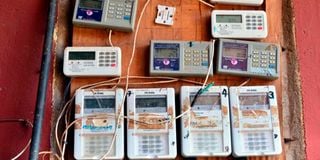Electricity consumption hits a record high in July

A prepaid electricity token machine provided by Kenya Power.
What you need to know:
- Power consumption grew five per cent in July compared to June to hit an all-time high of 1.126 billion units.
- It is also during the same month – on July 26 – that Kenya recorded the highest peak power demand hitting 2117 megawatts (MW).
- The record consumption points to the gains of subsidised power and rapidly rising economic activity.
Electricity consumption grew five per cent last month to hit a historic high, new data shows, as consumers took advantage of State subsidies that have kept electricity prices unchanged for eight consecutive months.
Data by the Energy and Petroleum Regulatory Authority (Epra) showed that power consumption grew five per cent in July compared to June to hit an all-time high of 1.126 billion units.
The electricity consumption in July surpassed the previous record of 1.093 billion units that were used in May this year.
It is also during the same month – on July 26 – that Kenya recorded the highest peak power demand hitting 2117 megawatts (MW).
Peak demand is a point in time during a 24-hour period when electricity demand is highest.
The record consumption points to the gains of subsidised power and rapidly rising economic activity as the country climbs out of the economic downturn linked to the Covid-19 pandemic.
Consumers' relief
Epra yesterday kept electricity prices unchanged for the eighth month in a row giving relief to consumers in a move that has helped grow electricity consumption.
Epra publishes new electricity prices monthly through a gazette notice to cater for fluctuations in fuel and water prices and foreign exchange rates.
While the government has subsidized the cost of fuel for both the July-August and August-September pricing cycles, the cost of fuel is still retailing at the highest prices on record.
Epra has however not adjusted these pass-through costs – the Fuel Cost Charge (FCC), Foreign Exchange Rate Fluctuation Adjustment (FERFA), and Water Resources Management Authority (WARMA) Levy - since December 2021.
The FCC is the single largest variable electricity cost adjusted monthly and is collected by Kenya Power to be reimbursed to thermal power generators for their fuel purchases used to generate power.
Subsidy deal
The government has however entered into a subsidy deal with Kenya Power to keep the prices stable to reduce the cost of living for households and the cost of doing business for firms.
About seven per cent of Kenya’s electricity is generated from thermal sources.
“Pursuant to Clause 1 of Part III of the Schedule of Tariffs 2018, notice is given that all prices for Electrical Energy specified in Part II of the said Schedule will be liable to a Fuel Energy Cost Charge of plus 463 Kenya cents per kWh for all meter readings to be taken in August 2022,” said Epra Director-General Daniel Kiptoo.
Higher electricity consumption is underpinned by increased economic activities in the key sectors of the economy such as trade, manufacturing, construction, agriculture, real estate as well as private households.
About 70 per cent of Kenya Power’s electricity is supplied to commercial customers.
The onset of the Covid-19 pandemic in March 2020 heavily affected the transport, hospitality, tourism, and trade sectors and saw a sharp fall in electricity demand due to the low business activities.
The reopening of the economy has however led to higher power demand surpassing the pre-pandemic demand levels amid government-backed interventions to reduce the cost of power.
Epra in January cut energy charge tariffs by 15 per cent which significantly reduced electricity costs with the State early this month announcing breakthrough talks with private power producers to further cut tariffs.





